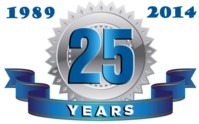

Vsystem Architecture
Modular, Flexible, Scalable
Benefits
- Keep systems running during changes - You are not required to shut down the whole system to make a single change--only the component affected need be shut down and restarted.
- Failures Isolated - If a component fails for any reason, the rest of the system will keep running and the failed component can be restarted.
- Modular Functionality - Development and testing more predictable and reliable.
- All Information Accessible - Because data are shared on a common bus, any process has access and can thus display them, process them, and archive them to disk.
- API is network-independent - Processes can be moved between computers without changes.
- Expand Information - Database channels can be defined for derived data and commands, such as “efficiency” and “stop process.”
- Simple Training Systems - Replacing the I/O connection module with a process simulator results in a training system.
- Examining Events and Operations - Removing the I/O connection module and using Playback allows the system to be used to study previously recorded operations.

Details
How can one picture this architecture? Consider an electronic bus, such as a VME, PLC, or computer backplane, into which
functional modules are plugged to make up the overall system. Each module has a defined function, graphics card, network card,
analog input card etc.etc. Our real-time database, Vaccess, can be thought of as the backplane, and the Vsystem components,
as well as optional user-written application code, are the modules that are plugged in. In fact they are hot-swappable as a result
of the independent process feature of the operating system and the internal design and implementation of Vaccess. While electronic
busses transmit data from a master to one (or more) slaves and interrupts from slaves to masters, Vaccess can do more. Implemented
as a shared global section with an API, Vaccess more closely models the data structures and requirements of real-time monitoring and control systems.
What Is A Channel?
The channels of Vaccess are the items of data that reflect the information associated with the application. What that
really means is that for each input sensor, temperature, pressure, status, flow, and so forth, there is an input channel defined
with the appropriate name. And for every control, open/close command, pump speed setting, analog output, on/off command, and so
forth, there is an output channel in Vaccess. Channels are also called tags or points.
Extending Channel Use
You can add channels to Vaccess that are used for high-level commands, derived data, and intermediate data. You
can then fully exploit the power of the Vaccess architecture by breaking down complex applications into the logical components
and implementing and testing them separately as computer processes communicating through Vaccess.
What Is In A Channel?
Each channel has many fields that can be used to centralize the information about that channel and add features to the processing
of the gets and puts of values. These features include
- Data conversion
- Alarm checking
- Output clipping
- User-defined value processing
- Data formatting
- Security Settings
- Text
- Formatting and units
- Location
How Many Channels? What Is The Performance?
Other important aspects of Vsystem are its scalability and networking. Because of the overhead of the TCP/IP stack and the limited
bandwidth of the network connection, Vsystem is designed to use the overall system as efficiently as possible. To achieve this, any
process on the network can not only read the current value of a channel and any field of any channel, but it can also request notification
of change of that field or any other field. Thus:
- Only data that have been requested and have changed are transmitted.
- Change events to be transmitted over the network are combined into messages.
- Architectural limits are 4 billion channels per instillation
- Data processing rates in the many millions of readings/secs/computer have been achieved.
Entire website - Copyright ©
2016 - 2021 Vista Control Systems, Inc. All Rights Reserved.
Information in this web site is subject to change without notice.
® Vista Control Systems, Inc., the Vista logo, and Vsystem are registered trademarks of Vista Control
Systems, Inc.
Vdraw, Vaccess, Vgen, Vlogger, Valarm, Vscript, Vscan, and
Vczar are trademarks of Vista Control Systems, Inc.
Use of this web site indicates you have read the Vista Privacy Policy
and accept the uses and restrictions described therein.
Site hosted by bluehost


